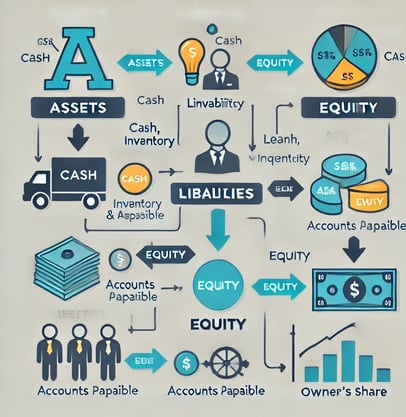Financial Foundations: Understanding Your Balance Sheet
A simple guide to understanding your balance sheet—breaking down assets, liabilities, and equity to help you assess your business’s financial health with confidence. description.
Charles Etgen
10/29/20243 min read


Financial Foundations: Understanding Your Balance Sheet
What You Own, What You Owe, and What You’re Worth
Introduction
Think of your balance sheet as a quick snapshot of your business’s financial health at any given moment. It captures what you own (assets), what you owe (liabilities), and what’s left over (equity). In short, it’s like your business’s financial selfie!
Let’s break it down into the essentials so you can start reading your balance sheet with confidence.
The Three Key Components of a Balance Sheet
1. Assets: What You Own
Overview: Assets are everything your business owns or controls that can create value. This includes cash, accounts receivable, inventory, and equipment.
Analogy: Think of assets as the contents of your personal bank account or valuable items you own. Just like cash in your checking account or a car in your driveway, business assets contribute to your total worth.
Types of Assets:
Current Assets: These are short-term assets like cash, inventory, and accounts receivable, which can quickly be turned into cash.
Fixed Assets: Long-term assets like property, machinery, and office equipment that contribute value over time.
Quick Tip: To check how “liquid” (easily accessible) your business is, look at your current assets—these are resources like cash, accounts receivable, and inventory that you can convert to cash within a year. High liquidity means you’re better prepared to cover short-term expenses or unexpected costs.
2. Liabilities: What You Owe
Overview: Liabilities represent what your business owes—debts, bills, and any other obligations. Common examples are loans, credit card balances, or accounts payable (unpaid bills).
Analogy: Think of liabilities like your personal debts or bills—credit card debt, mortgage payments, or money owed to friends. In business terms, they’re the expenses you’ve committed to but haven’t yet paid off.
Types of Liabilities:
Current Liabilities: Short-term obligations like bills, short-term loans, and credit lines, all of which are due within a year.
Long-Term Liabilities: Debts due in over a year, like large loans or mortgage payments for commercial property.
Quick Tip: To get a sense of your immediate financial health, focus on current liabilities. If you have enough current assets to cover these, you’re in a safe zone!
3. Equity: What You’re Worth
Overview: Equity, often called “owner’s equity,” is what remains once liabilities are subtracted from assets. Essentially, it’s the net worth of your business.
Analogy: Think of equity as your home ownership. If you’ve paid off most of your mortgage, the “owned” portion of your house is your equity. Similarly, business equity is what belongs to you or your shareholders after all debts are paid.
Formula to Remember:
Equity = Assets - Liabilities
This formula gives you a snapshot of what you “own” in your business after covering all debts.
Quick Tip: Higher equity means more value in your business, which can attract investors and make it easier to secure loans.
Takeaway: A Quick 3-Step Balance Sheet Check-Up
Here’s a simple, 3-step method for assessing your balance sheet:
Check Asset Coverage: Do your current assets cover current liabilities? This is called the current ratio:
Current Ratio = Current Assets / Current Liabilities
A ratio above 1 means you’re in a healthy spot to pay short-term debts.Analyze Debt-to-Equity: How much of your business is financed by debt versus ownership? Calculate the debt-to-equity ratio:
Debt-to-Equity Ratio = Total Liabilities / Equity
This helps you gauge financial stability. A lower ratio is generally safer.Review Changes Over Time: Look at your balance sheet quarterly or annually to spot trends. Are assets growing faster than liabilities? Are you building equity over time? Tracking changes helps you adjust strategies and monitor growth.
Extra Tips
1. Simple Formulas to Bookmark
Current Ratio = Current Assets / Current Liabilities
Debt-to-Equity Ratio = Total Liabilities / Equity
Equity = Assets - Liabilities
These are some basics that can help you quickly analyze financial stability and know where to dig deeper if needed.
2. Actionable Checklist
Review your balance sheet monthly to track trends.
Check if current assets cover current liabilities to assess short-term financial health.
Monitor the debt-to-equity ratio to stay on top of debt levels.
Set goals based on your findings: If liabilities are high, focus on debt reduction; if equity is strong, consider investments or growth opportunities.
Final Thought
Understanding your balance sheet is like knowing the pulse of your business. By regularly checking in, you’re better prepared to make informed financial decisions that help your business thrive.
#BusinessTips #BalanceSheetBasics #FinancialHealth #CurrentAssets #Liquidity #CashFlow #SmallBusinessFinance #EntrepreneurEssentials #FinancialFoundations
Services
Customized bookkeeping solutions for your business needs.
Call, text or email me Now
Support
Charles@etgenbookkeeping.com
© 2024. All rights reserved.
Or Click the Button Below to Schedule A Time That's Most Convenient For You!
570-730-9232
Here are my social media links at the moment:
